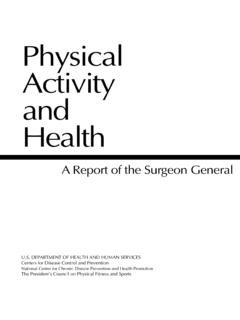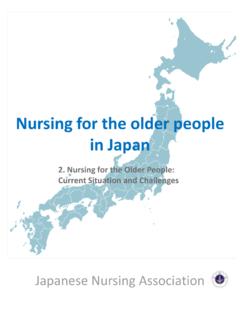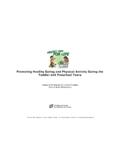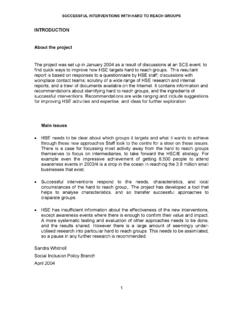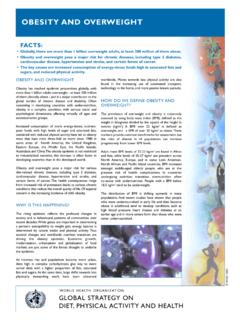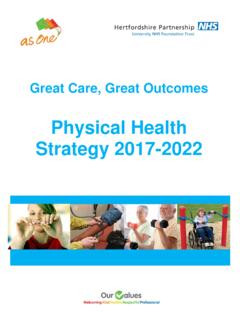Transcription of NON COMMUNICABLE DISEASE PREVENTION: …
1 A complementary document to The Toronto Charter for physical activity : A Global Call to Action Whole-of-communityapproaches where people live,work and recreate have theopportunity to mobilize largenumbers of | | FEBRUARY 2011 NON COMMUNICABLE DISEASE PREVENTION: Investments that Work for physical ActivityPhysical inactivity is the fourth leading cause of deaths due to noncommunicable DISEASE (NCDs) worldwide - heart DISEASE , stroke,diabetes and cancers - and each year contributes to over threemillion preventable deaths .1 physical inactivity is related (directlyand indirectly) to the other leading risk factors for NCDs such ashigh blood pressure, high cholesterol and high glucose levels; and,to the recent striking increases in childhood and adult obesity, notonly in developed countries but also in many developing scientific evidence supports the importance ofphysical inactivity as a risk factor for NCD independent of poordiet, smoking and alcohol misuse.
2 physical activity has comprehensive health benefits across thelifespan: It promotes healthy growth and development in childrenand young people , helps to prevent unhealthy mid-life weightgain, and is important for healthy ageing, improving andmaintaining quality of life and independence in older most recent global estimates indicate that 60% of theworld population are exposed to health risks due to population-wide participation in physical activity is amajor health priority in most high and middle income countriesand is a rapidly-emerging priority in lower income countriesexperiencing rapid social and economic Toronto Charter for physical activity (May 2010)
3 Outlines the direct health benefits and co benefits of investing inpolicies and programs to increase levels of physical translated into 11 languages, the Toronto Charter makes astrong case for increased action and greater investment onphysical activity as part of a comprehensive approach to NCDprevention. The Charter was developed with extensive world-widestakeholder consultation and calls foraction in four key areas consistent withthe WHO Global Strategy for Diet andPhysical activity : 1) national policy; 2)policies and regulations; 3) programs andenvironments.
4 And 4) is strong evidence to guide theimplementation of effective approaches toincrease physical ,5,6 Reversingdownward trends in physical activity willrequire countries to commit to acombination of strategies aimed at theindividual, social-cultural, environmentaland policy determinants of activity is influenced by policiesand practices in education, transportation,parks and recreation, media, and business,so multiple sectors of society need to beinvolved in the solutions. There is theclear need to inform, motivate andsupport individuals and communities tobe active in ways that are safe,accessible and enjoyable.
5 There is no one single solution toincreasing physical activity , an effective comprehensiveapproach will require multiple concurrent strategies to support countries ready to respond, there areseven best investments for physical activity , which aresupported by good evidence of effectiveness and that will haveworldwide applicability. 77 Best Investments for physical Activitysupport structured and unstructured physical activitythroughout the | | FEBRUARY 2011 1 Whole-of-school programsSchools can provide physical activity for the large majority of childrenand are an important setting for programs to help students developthe knowledge, skills and habits for life-long healthy and active whole of school approach to physical activity involves prioritizing:regular, highly-active, physical education classes.
6 Providing suitablephysical environments and resources to support structured andunstructured physical activity throughout the day ( , play andrecreation before, during and after school); supporting walk/cycle-to-school programs and enabling all of these actions through supportiveschool policy and engaging staff, students, parents and the widercommunity. More information on the best approaches to implementwhole of school approaches to physical activity is available from: Ribeiro IC, Parra DC, Hoehner CM, Soares J, Torres A, Pratt M, et physical education programs: evidence-based physicalactivity interventions for youth in Latin America.
7 Global HealthPromotion; 17(2) 2010. International Union for Health Promotion and Education (IUHPE).Achieving Health Promoting Schools: Guidelines for Promoting Health World Health Organisation. School policy framework: Implementation ofthe WHO global strategy on diet, physical activity and health. Geneva:World Health Organization; policies and systems that prioritise walking, cycling and public transport Active transport is the most practical and sustainable way to increase physical activity on a daily basis; and increasedactive transport will achieve co-benefits such as improved air quality, reduced traffic congestion, and reduced active transport requires the development andimplementation of policies influencing land use and access tofootpaths, bikeways and public transport, in combination witheffective promotional programs to encourage and support walking,cycling and use of public transport ( trains, trams and buses) fortravel purposes.
8 This combination of strategies can shift mode choiceaway from personal motorised vehicles and increase physical of successful actions are available worldwide. Moreinformation on the best approaches to increase non-motorisedtransport is available from: Pucher J, Dill J, Handy S. Infrastructure, programs, and policies toincrease bicycling: An international review. Prev Med. 50 S106 S125;2010. An Australian Vision for Active Transport. A report prepared byAustralian Local Government Association, Bus Industry Confederation,Cycling Promotion Fund, National Heart Foundation of Australia,International Association of Public Transport.
9 World Health Organization; A physically active life through everydaytransport with a special focus on children and older people andexamples and approaches from Europe. WHO Regional Office forEurope, Copenhagen | | FEBRUARY 2011 3 Urban design regulations and infra-structure that provide for equitable and safeaccess for recreational physical activity , andrecreational and transport-related walkingand cycling across the life courseThe built environment provides opportunities for or barriers to safe,accessible places for people to be involved in recreation, exercise,sports, walking and cycling.
10 National, regional, and local urban planning and design regulationsshould require mixed-use zoning that places shops, services, and jobsnear homes, as well as highly connected street networks that make iteasy for people to walk and cycle to destinations. Access to publicopen space and green areas with appropriate recreation facilities for allage groups are needed to support active recreation. Complete networksof footpaths, bikeways, and public transit support both active travel andactive recreation. More information on the best approaches to creatingurban environments that support physical activity is available from: National Institute for Health and Clinical Excellence (NICE) Promotingand creating built or natural environments that encourage and supportphysical activity .
